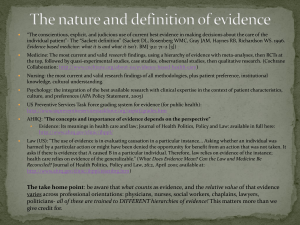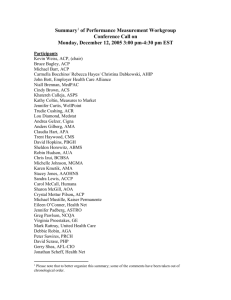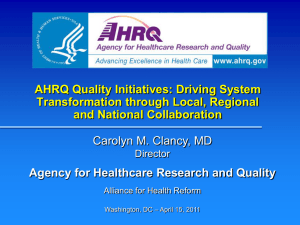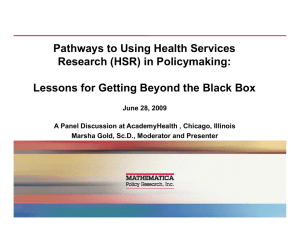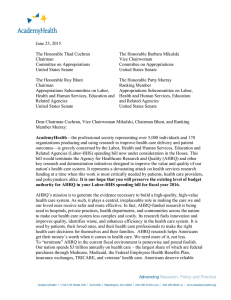6 om as a public service of the RAND Corporation.
advertisement
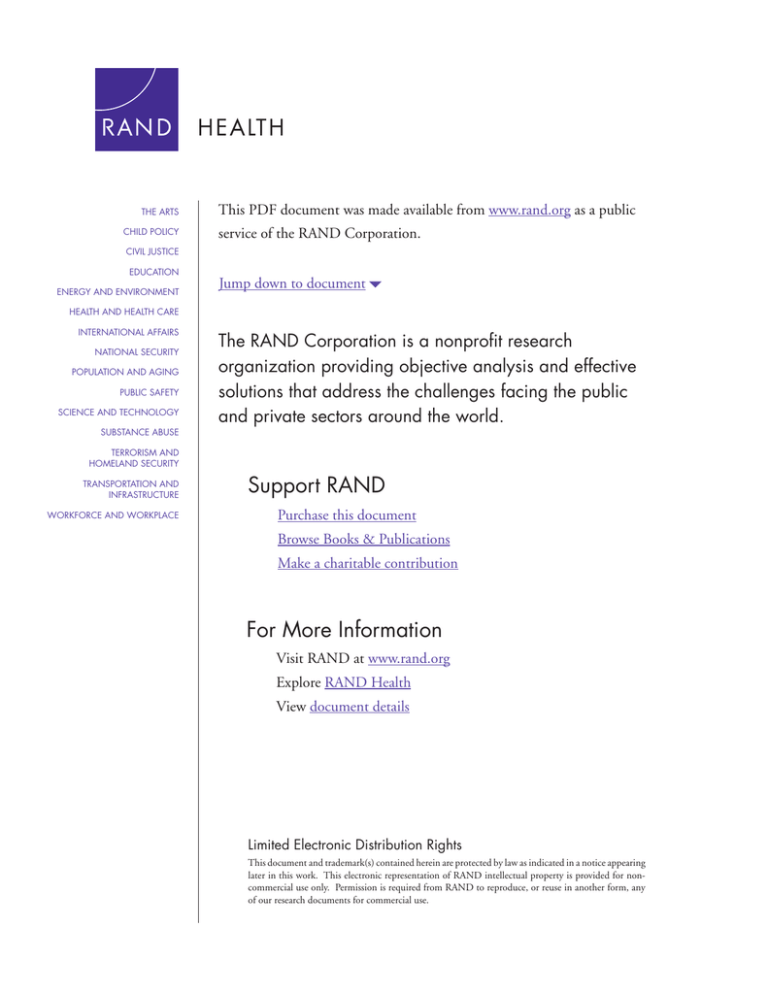
THE ARTS CHILD POLICY This PDF document was made available from www.rand.org as a public service of the RAND Corporation. CIVIL JUSTICE EDUCATION ENERGY AND ENVIRONMENT Jump down to document6 HEALTH AND HEALTH CARE INTERNATIONAL AFFAIRS NATIONAL SECURITY POPULATION AND AGING PUBLIC SAFETY SCIENCE AND TECHNOLOGY SUBSTANCE ABUSE The RAND Corporation is a nonprofit research organization providing objective analysis and effective solutions that address the challenges facing the public and private sectors around the world. TERRORISM AND HOMELAND SECURITY TRANSPORTATION AND INFRASTRUCTURE WORKFORCE AND WORKPLACE Support RAND Purchase this document Browse Books & Publications Make a charitable contribution For More Information Visit RAND at www.rand.org Explore RAND Health View document details Limited Electronic Distribution Rights This document and trademark(s) contained herein are protected by law as indicated in a notice appearing later in this work. This electronic representation of RAND intellectual property is provided for noncommercial use only. Permission is required from RAND to reproduce, or reuse in another form, any of our research documents for commercial use. This product is part of the RAND Corporation technical report series. Reports may include research findings on a specific topic that is limited in scope; present discussions of the methodology employed in research; provide literature reviews, survey instruments, modeling exercises, guidelines for practitioners and research professionals, and supporting documentation; or deliver preliminary findings. All RAND reports undergo rigorous peer review to ensure that they meet high standards for research quality and objectivity. Assessment of the AHRQ Patient Safety Initiative Moving from Research to Practice Evaluation Report II (2003–2004) Donna O. Farley, Sally C. Morton, Cheryl L. Damberg, M. Susan Ridgely, Allen Fremont, Michael D. Greenberg, Melony E. Sorbero, Stephanie S. Teleki, Peter Mendel Prepared for the Agency for Healthcare Research and Quality This work was sponsored by the Agency for Healthcare Research and Quality under contract No. 290-02-0010. The research was conducted in RAND Health, a division of the RAND Corporation. Library of Congress Cataloging-in-Publication Data Assessment of the AHRQ patient safety initiative : moving from research to practice evaluation report II (2003–2004) / Donna O. Farley ... [et al.]. p. cm. Includes bibliographical references. ISBN 978-0-8330-4148-7 (pbk. : alk. paper) 1. Medical errors—Prevention—Government policy—United States. 2. Iatrogenic diseases—Prevention— Government policy—United States. 3. Patients—United States—safety measures. I. Farley, Donna. II. Rand Corporation. III. United States. Agency for Healthcare Research and Quality. IV. Title: Assessment of the Agency for Healthcare Research and Quality patient safety initiative. [DNLM: 1. Medical Errors—prevention & control—United States. 2. Government Programs—United States. 3. Program Evaluation—United States. WB 100 A8383 2007]. R729.8.A873 2007 610.28'9—dc22 2007008394 The RAND Corporation is a nonprofit research organization providing objective analysis and effective solutions that address the challenges facing the public and private sectors around the world. RAND’s publications do not necessarily reflect the opinions of its research clients and sponsors. R® is a registered trademark. © Copyright 2007 RAND Corporation All rights reserved. No part of this book may be reproduced in any form by any electronic or mechanical means (including photocopying, recording, or information storage and retrieval) without permission in writing from RAND. Published 2007 by the RAND Corporation 1776 Main Street, P.O. Box 2138, Santa Monica, CA 90407-2138 1200 South Hayes Street, Arlington, VA 22202-5050 4570 Fifth Avenue, Suite 600, Pittsburgh, PA 15213-2665 RAND URL: http://www.rand.org/ To order RAND documents or to obtain additional information, contact Distribution Services: Telephone: (310) 451-7002; Fax: (310) 451-6915; Email: order@rand.org EXECUTIVE SUMMARY As of October 2004, it has been three years since the U.S. Congress funded the Agency for Healthcare Research and Quality (AHRQ) to establish the national patient safety research and implementation initiative. With these funds, AHRQ has committed to improving patient safety in the U.S. health care system by developing a comprehensive strategy for supporting expansion of knowledge about patient safety epidemiology and effective practices and by identifying and disseminating the most effective practices. AHRQ contracted with the RAND Corporation in September 2002 to serve as the evaluation center for its patient safety initiative. The evaluation center is responsible for performing a longitudinal evaluation of the full scope of AHRQ’s patient safety activities and for providing regular feedback to support the continuing improvement of this initiative. This report—Moving from Research to Practice: Evaluation Report II—is the second of four annual evaluation reports to be prepared by the evaluation center. The first report—Context and Baseline: Evaluation Report I (Farley et al., 2005)—covers the period from October 2002 through September 2003, and it focuses on assessing the context and goals that served as the foundation for the patient safety initiative and on developing baseline information for the process evaluation. Evaluation Report II covers October 2003 through September 2004, during which the evaluation continued to document activities, progress, and issues involved in (1) conducting the AHRQ-funded patient safety projects; (2) building the infrastructure to support implementation of improved patient safety practices; and (3) disseminating research results and products. In addition, we present a framework and possible measures for evaluating the effects of the patient safety initiative on outcomes for patients and stakeholders other than patients. EVALUATION FRAMEWORK The Policy Context In early 2000, the Institute of Medicine (IOM) published the report To Err Is Human: Building a Safer Health System, which mobilized national efforts to improve the safety of the U.S. health care system (Kohn, Corrigan, and Donaldson, 2000). The IOM called for leadership from the Department of Health and Human Services (DHHS) in reducing medical errors, identifying AHRQ as the national focal point for patient safety research and practice improvements. In response to the IOM report, the Quality Interagency Coordination Task Force (QuIC) identified more than 100 actions designed to create a national focus on reducing errors, strengthening the patient-safety knowledge base, ensuring accountability for safe health care delivery, and implementing patient safety practices (QuIC, 2000). The AHRQ patient safety work is one of numerous and important patient safety initiatives being undertaken by a variety of organizations across the country. AHRQ’s leadership can provide motivation and guidance for the activities of others. And, by integrating its work with that of public and private organizations, the agency can leverage finite resources and achieve synergy through collaboration. The Evaluation Model The overall evaluation design is based on the Context-Input-Process-Product (CIPP) model, which is a well-accepted strategy for improving systems that encompasses the full spectrum of factors involved in the operation of a program (Stufflebeam et al., 1971; xi Stufflebeam, Madaus, and Kellaghan, 2000). The core model components are represented in the CIPP acronym: x Context evaluation assesses the circumstances stimulating the creation or operation of a program as a basis for defining goals and priorities and for judging the significance of outcomes. x Input evaluation examines alternatives for goals and approaches for either guiding the choice of a strategy or assessing an existing strategy against the alternatives. x Process evaluation assesses progress in implementing plans relative to the stated goals for future activities and outcomes. x Product evaluation identifies consequences of the program for various stakeholders, intended or otherwise, to determine the effectiveness of and provide information for future program modifications. A Framework for the Process Evaluation The process evaluation is the largest and most complex component of the evaluation because many aspects of the health system are affected by AHRQ’s work and that of numerous other organizations involved in patient safety. We adopted a national perspective, the goal of which was to assess the progress of the AHRQ initiative and the activities of other federal agencies in the context of the larger U.S. patient safety system. We identified five system components that are essential to bringing about improved practices and a safer health care system for patients. Together, these components provide a cohesive framework for the process evaluation. They work together to bring about improved practices and a safer health care system for patients, as shown in Figure S.1. The components are (1) monitoring progress and maintaining vigilance; (2) establishing knowledge of the epidemiology of patient-safety risks and hazards; (3) developing effective practices and tools; (4) building infrastructure for effective practices; and (5) achieving broader adoption of effective practices. Our process evaluation examined progress in strengthening each of these components. Knowledge development Knowledge of Epidemiology of Patient Safety Risks and Hazards Practice Implementation Building Infrastructure for Effective Practices Development of Effective Practices and Tools Achieving Broader Adoption of Effective Practices Monitoring Progress and Maintaining Vigilance Figure S.1 The Components of an Effective Patient Safety System The component for monitoring progress and maintaining vigilance is identified first and placed on the bottom left side of the figure, reflecting the need for early data on patient safety issues to help guide intervention choices, as well as ongoing feedback regarding progress in xii developing knowledge and implementing practice improvements. The top row of the figure contains the two components that contribute to knowledge development regarding patient-safety epidemiology and effective practices and tools. This knowledge is then used in the remaining two model components, which contribute to practice implementation—building infrastructure and adopting effective practices (in the second row of the figure). FINDINGS FROM THE CONTEXT AND INPUT EVALUATIONS Context Evaluation External events continue to influence the patient-safety strategy and activities of AHRQ and other federal agencies. In Evaluation Report I, we identified the following consequences for AHRQ: a clear mandate by Congress for AHRQ leadership; a need to balance research and implementation; resource constraints; accountability for results; and coordination of multiple activities. Two subsequent major events have altered the scope of the patient safety initiative or were expected to do so. The first is the shift in focus of patient safety appropriations toward grants that advance the implementation of health information technology (health IT). The second is the impending passage of legislation that would create protections for adverse-event reporting systems and establish patient safety organizations (PSOs). Input Evaluation During FY 2004, AHRQ made several changes to its overall management and focus that have implications for the agency’s approach to implementing patient safety improvements: x Adoption of a new mission and strategic plan designed to improve quality and safety in health care through a combination of scientific research and actions. x Establishment of ten portfolios of work that are intended to achieve greater synergy among related activities undertaken across the five AHRQ centers and to provide clearer information to external audiences about what the agency does. x Establishment of the Research Empowering America’s Changing Healthcare System (REACH) program to design and support performance-improvement implementation activities. Cumulative funding for patient safety projects has generated a substantial body of work since FY 2000. The six systems-related best-practice grants funded in FY 2000 were followed by 75 projects in six groups, funded in FY 2001. The 13 patient safety challenge grants were funded in FY 2003, and the first health-IT grants and contracts were funded in FY 2004 (108 projects). Collectively, these policy, organizational, and project-funding changes have several implications for AHRQ’s future activities, including the need to create an interdisciplinary culture for action, balance its expanded implementation function with its traditional research role, and prepare for pending PSO legislation. FINDINGS AND ACTION OPPORTUNITIES FROM THE PROCESS EVALUATION Monitoring Progress and Maintaining Vigilance (Chapter 3) AHRQ-sponsored activities for the development of a national-level data network capability proceeded on several fronts in 2003–2004. Several AHRQ-funded projects have generated important contributions to building a patient-safety reporting and data infrastructure, including xiii the IOM data standards project, the federal data system project, and activities of the 16 reporting demonstrations that were part of the FY 2001 group of patient safety grants. Other AHRQsupported activities also show promise in this area, including the Patient Safety Improvement Corps (PSIC), work on a common taxonomy for patient-safety-reporting systems, and funding of state-level health-IT demonstrations. AHRQ faces both an opportunity and a challenge to play a key role in bringing about a national-level patient safety data network with the capability to monitor patient safety performance data and enable sharing of information across organizations. AHRQ’s leadership will be required to stimulate dissemination and adoption of data and system standards, including working closely with end users to ensure that the system designs are serving their needs. More work also is needed on developing a comprehensive set of patient safety measures that address care across health care settings and on encouraging adoption of these measures by accreditation and credentialing organizations. Suggestions for AHRQ Action x As the state and regional health information systems projects progress, AHRQ should leverage this work to encourage broad use of the data standards recommended in the 2004 IOM report (Aspden et al., 2004). x AHRQ should build upon the technical products of the federal data system project by pursuing expanded use of the newly developed reporting and data-warehouse capability, with the goal of moving toward a national data repository with multiple public and private users. x AHRQ should place a priority on establishing a broader set of national patient safety measures that represent the most important safety aspects of the patient’s health care experience in a variety of settings. To do so, it should use a structured consensus process involving multiple stakeholders and build upon the existing Patient Safety Indicators. x AHRQ should invite accreditation and credentialing organizations and insurers to be actively involved in the process for establishing national patient safety measures and designing a reporting network, with the goal of adopting the measures as standards in their accreditation processes. Establishing Knowledge of the Epidemiology of Patient Safety Risks and Developing Effective Practices and Tools (Chapter 4) The contribution of AHRQ-funded projects to the knowledge base on patient safety epidemiology and practices continues to grow. Although only a relatively small share of the total knowledge that these projects are likely to generate has surfaced thus far, much more will become available with the publication of the AHRQ compendium of patient safety papers and subsequent journal articles. Recent additions to this body of work are the 13 challenge grants funded in FY 2003, which focus on implementation strategies to address a broad range of patient safety issues. As results emerge from the patient safety projects, it will be critical to synthesize them in ways that make the information accessible to various end users. These include the scientific community, which will use the results for updating the body of evidence on patient safety practices, and the health care community, which will adopt the new practices that have been shown to be effective. Health care providers also need to know the business case for practices, which is not being addressed well by the funded projects. AHRQ has been preparing to perform these syntheses. xiv Suggestions for AHRQ Action x AHRQ should ensure that the results of epidemiological studies by the patient safety projects are summarized in usable forms for a variety of stakeholders and for future decisions on patient safety priorities. x AHRQ should establish definitions and standards for measurement methods as the basis for valid and consistent epidemiological estimates for patient safety issues. x AHRQ should fund the development of a review report that summarizes the current state of knowledge on patient safety epidemiology and presents the best available estimates of the incidence and severity of errors and adverse events. x AHRQ should commit resources to define the standards of evidence that should apply for assessing the effectiveness of patient safety practices. To this end, AHRQ should support a panel process to produce recommendations for standards of evidence for patient safety. x As the patient safety projects generate new evidence on practices and as standards of evidence have been adjusted to apply more effectively to patient safety practices, AHRQ should update the evidence report on patient safety to incorporate new evidence for widespread availability to users. x AHRQ should pursue a twofold strategy to generate information on the business case for promising patient safety practices: (1) Require all of its funded patient-safety projects that are conducting practice interventions to collect and report data on implementation costs as part of their research; and (2) identify some of the projects that have successful interventions and separately fund analyses of the cost-effectiveness and return on investment for those interventions. x For subsequent patient-safety-implementation grants, AHRQ should focus on funding efforts by nonacademic medical centers, to improve the generalizability of findings on patient safety practices. x AHRQ should consider the development of a noncompetitive renewal mechanism for especially promising patient safety projects. Building Infrastructure for Effective Practices (Chapter 5) Analyses of three disparate infrastructure-development activities—partnership activities, the PSIC, and consumer involvement in patient safety—reveal an active infrastructure-building process for supporting patient safety improvements. From interviews with 35 organizations, we identified 135 partnerships among 98 participating organizations. As AHRQ expands its outreach for implementation, we should find increased AHRQ involvement in partnerships when this analysis is repeated in 2005–2006. The PSIC participants are bringing their new skills home to train others and put the techniques to work. In addition, active consumer involvement in the patient safety activities of local health care organizations is gaining momentum. As AHRQ considers future options for extending its role in the development of partnerships and the PSIC, it will need to choose strategically where to invest its limited resources. Consumers should continue to be the spearhead of future consumer-involvement actions, but there are ways in which AHRQ might help them accomplish their goals. xv Suggestions for AHRQ Action x AHRQ should seek out new strategic partnerships, especially in areas where little collaboration currently exists, while strengthening existing partnerships. x Wherever possible, AHRQ should eliminate real and perceived barriers to partnering with other organizations (private or public). x AHRQ should seek ways to maintain and build on the network of trainees who have gone through the Patient Safety Improvement Corps training. x AHRQ should expand the Patient Safety Improvement Corps model to include stakeholders in addition to state governments and hospitals. x AHRQ should fund Centers of Excellence for Consumer Engagement to study the effect of involving patients and families in patient safety activities. x AHRQ should partner with consumer organizations and organizations with expertise involving patients and families to disseminate best practices for consumer engagement in patient safety improvement. x AHRQ should encourage the use and evaluation of information technology to increase consumer awareness of patient safety issues and provide a means for consumers to report errors at the time they occur. Achieving Broader Adoption of Effective Practices (Chapter 6) It is a significant challenge to translate research findings into practice by end users so that changes toward a patient-safety culture and improved practices can be achieved in the U.S. health care system. End users view AHRQ as a leader in patient safety research and knowledge. Its contribution to knowledge is being seen in early evaluation results. AHRQ-funded projects were found to have generated 70 new products between July 2003 and July 2004, 61 of which were journal articles, suggesting that project leaders continue to focus on traditional peerreviewed publications for communicating research results. Because AHRQ is not an organization on the “front line” of health care delivery—where changes in practices need to occur to improve safety—it is essential for AHRQ to identify and develop strategic partnerships with those who can provide the translation bridge to end users and the systems in which they work. AHRQ should continue to explore how to best use its existing programs and funding mechanisms to engage end users in adopting safe practices. Although this step can be taken in the absence of new funding, these programs would benefit from additional resources that would allow AHRQ to make significant inroads in changing the American health care system. At the current level of staff and budget, the agency’s influence as a change agent in transforming health care may be seriously constrained. Suggestions for AHRQ Action x AHRQ should develop and implement a strategic plan that specifies how the agency will disseminate new patient-safety knowledge and products to the broad spectrum of stakeholders, as well as actions it will take to facilitate adoption of new and safer practices. x AHRQ should expand its internal infrastructure and budget to support future knowledgetransfer and dissemination work, so that its work is funded appropriately, has effective leadership and appropriate expertise to conduct the work, and has the support of the agency director. xvi x AHRQ should expand investment in AHRQ’s existing programs that support practice adoption, using those programs strategically to promote translation of patient safety research into practice, with specific guidance on which patient safety applications should be pursued. x AHRQ should develop “mentoring grants” that extend the successful work of implementation grantees more broadly across the health care system by enabling them to provide implementation support to other organizations. x AHRQ should seek to build partnerships with health-care providers and other end users to secure their input at the front end of the research process (so that research products are enduser-driven) and by extending the resources and reach of the agency for translation and diffusion of practices. THE PRODUCT EVALUATION AND SELECTION OF MEASURES To assess the effects of the patient safety initiative, this evaluation will establish a foundation of data sources and defined measures that can serve as a starting point for ongoing monitoring of progress in improvements in patient safety practices and outcomes. In identifying candidate measures of effects of the patient safety initiative, we include effects on both patient outcomes and stakeholders other than patients, as well as effects on infrastructure development and the introduction of proven patient safety practices. For example, measures are being explored for patient outcomes (e.g., hospital readmission rates, adverse medication events, patient-reported events), effects on other stakeholders (i.e., providers, state governments), and effects on infrastructure development (e.g., National Quality Forum patient safety events in state reporting systems). As AHRQ updates its patient safety strategy, this evaluation resource can be built into its scope of work to enable assessments of effects to continue after this evaluation is completed. This work also may help increase data availability by encouraging data collection by other organizations, which would contribute to content development for a national patient safety data network. Suggestions for AHRQ Action x AHRQ should develop Consumer Assessment of Healthcare Providers and Systems (CAHPS®) surveys or survey modules for patients to report on patient safety issues in ambulatory care, hospital services, and long-term care settings. x AHRQ should work with organizations in the field to initiate measurement capabilities for tracking effects for which data sources do not yet exist. NEXT STEPS FOR THE EVALUATION In 2004, nearly five years since the publication of the IOM report To Err Is Human, the national patient safety initiative has gained full momentum, and AHRQ is expanding its activities from knowledge development to implementation. From our observations of AHRQ’s patient safety strategy and the current activities of its grantees and field organizations, we have identified several priorities that we encourage ARHQ to pursue in the near future: x Facilitate movement toward a national patient safety data repository by encouraging use of consistent data standards, as recommended by the IOM, and establish a set of national patient-safety measures for assessing performance. xvii x Disseminate patient-safety knowledge and products from the FY 2000–FY 2001 projects, including development of “off-the-shelf” products that can be used readily by health care organizations. x Modify the standards of evidence used to assess the effectiveness of patient safety practices, to enable rigorous assessment of practices that cannot be tested using randomized control study designs. x Assess the role of health information technology in achieving safer health care practices and its interface with the human aspects of care delivery, using results of the newly funded health-IT grants as well as knowledge generated by other patient safety projects that have addressed the use of technology for patient safety practices. x Provide mechanisms to support consumer-led organizations in their pursuit of active patient involvement with health care organizations for actions to achieve safer care, including dissemination of the models they are using to a broader health care audience. x Expand partnerships with other organizations involved in patient safety to achieve synergy in patient safety improvements by leveraging the combined expertise of these organizations and AHRQ’s finite resources. In 2004–2005, as the patient safety evaluation center embarks on the third year of its work, the RAND project team will continue gathering information on the evolution of the patient safety initiative through our process-evaluation activities. At the same time, we will begin to collect and analyze data for the product evaluation, assessing the effects of the initiative on patient outcomes and stakeholders other than patients. xviii
